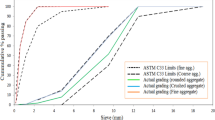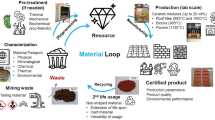Abstract
An alternative and environmentally benign method of disposing the buffing dust, generated from leather industry was carried out in the present investigation. The buffing dust (finished solid waste) was charred in a controlled oxygen atmosphere by coupled pyrolysis and the resultant material was gauged for the application of light weight cement blocks. The results confirmed that, at a flow rate of 1 LPM oxygen supplied for 30 min produced nanostructured fibrous carbon material which was further confirmed through SEM and EDX analyses. Iron nanoparticles were used to inhibit the conversion of trivalent chromium to hexavalent chromium in fibrous carbon before being utilized for making light weight cement block. The addition of iron nanoparticles supplements the mechanical strength by compositional bonding in cement block. The XRD results elucidate that the hexavalent chromium has reduced to trivalent chromium due to the addition of iron nanoparticles in the residue material. The as-prepared light weight cement blocks were fabricated (7 cm × 7 cm × 7 cm) for compression test, simultaneously cement block devoid of iron nanoparticles was prepared as a control. The compressive strength of the light weight cement block comprising of iron nanoparticles (20.7 kN/cm2) was found to be higher than the block without iron nanoparticles (3.82 kN/cm2).






Similar content being viewed by others
Abbreviations
- cBD:
-
Charred buffing dust
- LPM:
-
Litre per minute
- BDL:
-
Below desirable limit
- SEM:
-
Scanning electron microscopy
- EDX:
-
Energy dispersive X-ray
- XRD:
-
X-ray diffraction
- EVM:
-
Expert group on vitamins and minerals
- MET:
-
Minimum eliciting threshold
References
Buljan J, Reich G, Ludvik J (2000) Mass balance in leather processing, US/RAS/92/120, Regional programme for pollution controlling the tanning industry
Swarnalatha S, Ramani K, GeethaKarthi A, Sekaran G (2006) Starved air combustion—solidification/stabilization of primary chemical sludge from a tannery. J Hazard Mater 137:304–313
Sethuraman C, Srinivas K, Sekaran G (2013) Double pyrolysis of chrome tanned leather solid waste for safe disposal and products recovery. J Sci Ind Res 4(11):61–67
Ozgunay H, Colak S, Mutlu M, Akyuz F (2007) Characterization of leather industry wastes. J Environ Stud 16(6):867–873
EFSA Panel on Food Additives and Nutrient Sources added to Food (2010) Scientific Opinion on the safety of trivalent chromium as a nutrient added for nutritional purposes to foodstuffs for particular nutritional uses and foods intended for the general population (including food supplements). EFSA J 8(12):1882
Swarnalatha S, Srinivasulu T, Srimurali M, Sekaran G (2008) Safe disposal of toxic chrome buffing dust generated from leather industries. J Hazard Mater 150:290–299
Mu C, Lin W, Zhang M, Zhu Q (2003) Towards zero discharge of chromium-containing leather waste through improved alkali hydrolysis. J Waste Manag 23:835–843
Leonard A, Lawverys RR (1980) Carcinogenicity and mutagenicity of chromium. Mutat Res 76:227–239
Love G (1983) Chromium-biological and analytical considerations. In: Burrows D (ed) Chromium: metabolism and toxicity. CRC Press, Boca Raton
Sekaran G, Shanmugasundaram KA, Mariappan M (1998) Characteization and utilization of CTLW generated by the leather industry. J Hazard Mater 63:53–68
Fela K, Ciurowa KW, Konopka M, Wozny Z (2008) Present and prospective leather industry waste disposal. J Chem Techno1 3(3):53–55
Kolomaznik K, Adamek M, Andel I, Uhlirova M (2008) Leather waste-potential threat to human health, and a new technology of its treatment. J Hazard Mater 160:514–520
Conner JR (1990) Chemical fixation and solidification of hazardouswastes. Van NostrandReinhad Publisher, New York, pp 26–30
Filibelix A, Buyukkamaci N, Senol H (2000) Solidification of tannery wastes. J Resour Conserv Recycling 29:251–261
Silveire BI, Dantas AEM, Blasques JEM, Santos RKP (2003) Effectiveness of cement based systems for stabilization and solidification of spent liquor inorganic fraction. J Hazard Mater 98:183–190
Yilmaz O, KantarliIC YukselM, Saglam M, Yanik J (2007) Conversion of leather wastes to useful products. J Resour Conserv Recycl 49:436–448
Singh R, Misra V, Pratap R (2011) Synthesis, characterization and role of zero-valent iron nanoparticle in removal of hexavalent chromium from chromium-spiked soil. J Nanoparticle Res 13:4063–4073
Singh IB, Singh DR (2003) Effects of pH on Cr–Fe interaction during Cr(VI) removal by metallic iron. Environ Sci Technol 24:1041–1047
Lenore SC, Arnold EG, Rhodes RT (1985) Standard methods for the examination of water and wastewater, vol 1193, 17th edn. American Public Health Association, Washington
Xu Y, Zhao D (2007) Reductive immobilization of chromate in water and soil using stabilized iron nano-particles. Water Res 41:2101–2108
Sun Y-P, Cao J, Zhang W-X, Wang HP (2006) Characterization of zero-valent iron nanoparticles. Adv Colloid Interface Sci 120:47–56
Nethercott J, Paustenbach D, Adams R et al (1994) A study of chromium induced allergic contact dermatitis with 54 volunteers: implications for environmental risk assessment. Occup Environ Med 51:371–380
Rudzki E, Zakrzewski Z, Prokopczyk G, Kozlowska A (1978) Contact sensitivity to trivalent chromium compounds. Derm Beruf Umwelt 26:83–85
Acknowledgments
We thank CSIR, India for providing financial assistance through net work project SUSTRANS (ESC 0106) to carry out the work.
Author information
Authors and Affiliations
Corresponding author
Ethics declarations
Conflict of interest
The authors declare that, there is no conflict of interest financially and personally in the submission of this research article.
Rights and permissions
About this article
Cite this article
Sivaprakash, K., Maharaja, P., Pavithra, S. et al. Preparation of light weight constructional materials from chrome containing buffing dust solid waste generated in leather industry. J Mater Cycles Waste Manag 19, 928–938 (2017). https://doi.org/10.1007/s10163-016-0494-z
Received:
Accepted:
Published:
Issue Date:
DOI: https://doi.org/10.1007/s10163-016-0494-z




